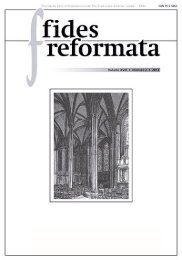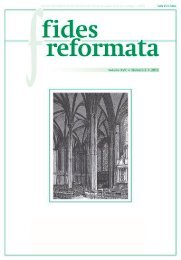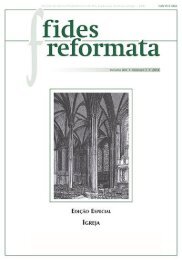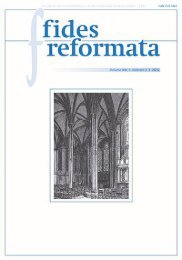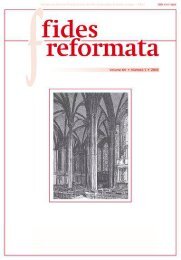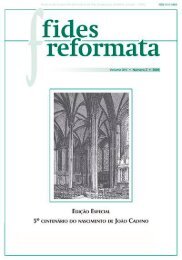You also want an ePaper? Increase the reach of your titles
YUMPU automatically turns print PDFs into web optimized ePapers that Google loves.
Breno Mace<strong>do</strong>, Covenant Theology in the Thought of John Calvin<br />
and his magnum opus, the Institutes, are still read, researched, and analyzed by<br />
many today. His influence not only in theology, but in society and economy,<br />
is widely recognized. Regardless of one’s love or hate for him, all ought to<br />
acknowledge the historical reality of this man’s achievements.<br />
When it comes to understanding Calvin’s thought, many have tried to<br />
identify the central <strong>do</strong>gma, the structural principle of Calvin’s theology. Several<br />
have been proposed, but there is still no positive consensus among scholars. 1<br />
From the debate at least one certainty seems to have emerged and become an<br />
accepted position in scholarly circles: if there is a central <strong>do</strong>gma <strong>do</strong>minating<br />
Calvin’s thought, most certainly it is not covenant theology. Everett H. Emerson<br />
explains that “Calvin himself, like many other Christian theologians, spoke<br />
of a divine covenant, but because the covenant is not a basic element for his<br />
system, he is not regarded as a covenant theologian.” 2 However, as Emerson<br />
affirms, no one would deny that the <strong>do</strong>ctrine of the covenant is present in all<br />
of Calvin’s works from the Institutes to his commentaries. It may not be the<br />
center of his system, if he has a system at all, but as a fruit of his exegetical<br />
genius and of his Sola Scriptura, the covenant is found in crucial topics of<br />
Calvin’s theology like creation, predestination, justification, sanctification,<br />
sacraments, and church discipline.<br />
The goal of this article is to investigate Calvin’s writings in search for<br />
the reformer’s views on the divine covenants and to organize them in the generally<br />
accepted division of the <strong>do</strong>ctrine: works and grace. Calvin’s <strong>do</strong>ctrine<br />
of the covenant of grace will be analyzed in terms of its five most accepted<br />
dispensations: Noahic, Abrahamic, Mosaic, Davidic, and New Covenant. The<br />
article will systematize Calvin’s thought in terms of the basic elements of a<br />
covenantal relationship: the existence of a covenant, its parties, characteristics,<br />
1 The central <strong>do</strong>gma metho<strong>do</strong>logy is one of the most common approaches to the study of Calvin’s<br />
thought. Cornelis Venema explains that the method consists of finding “the key to Calvin’s theology in<br />
one <strong>do</strong>minant theme. A central idea or motif in Calvin’s though is regarded as the basis for its various subthemes.<br />
Implicit in this approach is the conviction that Calvin was, in contrast to the other reformers and<br />
Luther in particular, the author of a theological system whose various aspects constitute an inter-related<br />
and inter-connected pattern of ideas.” Cornelis P. Venema, Accepted and Renewed in Christ: The Twofold<br />
Grace of God and the Interpretation of Calvin’s Theology (Göttingen: Vandenhoeck & Ruprecht, <strong>20</strong>07),<br />
14. While Luther dedicated more attention to the <strong>do</strong>gma of justification by faith, several theologians<br />
believe that the central theme in Calvin’s theology is the <strong>do</strong>ctrine of God, with special focus on God’s<br />
sovereignty and predestination. For more on this subject, see Charles Partee, “Calvin’s Central Dogma<br />
Again,” The Sixteenth Century Journal 18, n. 2 (July 1987): 191-<strong>20</strong>0; Richard A. Muller, “Calvin and<br />
the ‘Calvinists’: Assessing Continuities and Discontinuities between the Reformation and Ortho<strong>do</strong>xy,”<br />
Calvin Theological Journal 30, n. 2 (November 1995): 345-375; Richard A. Muller, Calvin and the<br />
Reformed Tradition: On the Work of Christ and the Order of Salvation (Grand Rapids, MI: Baker Academic,<br />
<strong>20</strong>12), 13-50; François Wendel, Calvin: Origins and Development of His Religious Thought, trans.<br />
Philip Mairet, first Labyrinth Press edition (Grand Rapids, Mich.: Baker Academic, 1995), 263-284.<br />
2 Everett H. Emerson, “Calvin and Covenant Theology,” Church History 25, n. 2 (June 1956): 136.<br />
90






